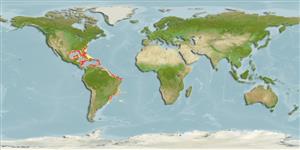Common names from other countries
Ophiuroidea |
Amphilepidida |
Amphiuridae
Environment: milieu / climate zone / depth range / distribution range
Ecology
Reef-associated; depth range 1 - 986 m (Ref. 111335). Tropical
Western Central Atlantic: Belize.
Length at first maturity / Size / Weight / Age
Maturity: Lm ? range ? - ? cm
Found on seagrass Halimeda sp., and corals Porites sp., Madracis sp., and Agaricia sp. (Ref. 86568).
Life cycle and mating behavior
Maturity | Reproduction | Spawning | Eggs | Fecundity | Larvae
The mode of reproduction is brooded embryos.
Hendler, G. and D.L. Pawson. 2000. (Ref. 86570)
IUCN Red List Status
(Ref. 130435: Version 2025-1)
CITES status (Ref. 108899)
Not Evaluated
Not Evaluated
Threat to humans
Human uses
| FishSource |
Tools
More information
Trophic EcologyFood items (preys)
Diet composition
Food consumption
Predators
Population dynamicsGrowthMax. ages / sizesLength-weight rel.Length-length rel.Length-frequenciesMass conversionAbundance Life cycleReproductionMaturityFecunditySpawningEggsEgg developmentLarvae PhysiologyOxygen consumption
Human RelatedStamps, coins, misc.
Internet sources
Estimates based on models
Preferred temperature
(Ref.
115969): 22.9 - 28, mean 25.6 (based on 314 cells).
Price category
Unknown.
